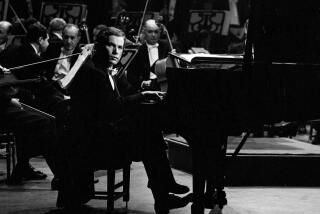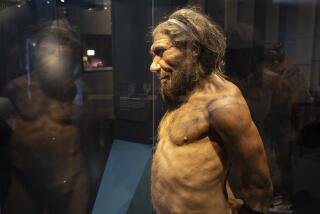Natural selections
- Share via
THE paleontologist Stephen Jay Gould died of lung cancer five years ago, at age 60. On the first of what will surely be a string of future Gould celebrations, his longtime publisher, W.W. Norton, has issued “The Richness of Life,” an anthology of his writings, drawn from his more than 20 books, most of them compiled from numerous essays and magazine pieces -- 300 columns in Natural History magazine alone.
The commemoration of a mere fifth anniversary might seem slight excuse for publishing such a wrap-up were it not for the high degree of public interest in questions that occupied Gould for nearly his entire life. (He took up paleontology at age 5, when he first clapped eyes on the skeleton of Tyrannosaurus rex lording it over the dinosaur exhibit in the American Museum of Natural History.) Not since the Scopes trial in 1925 has there been such a concerted attack on Charles Darwin’s theory of evolution by natural selection.
Gould, on the faculty of Harvard from 1967 until his death, was a great champion of that theory. What is less appreciated, perhaps, is that he was also one of its leading critics -- albeit also a committed foe of the proponents of intelligent design (who, back when he was in the thick of the battle, were known as creationists).
In his quarrels with such ultra- or neo-Darwinists as Richard Dawkins and John Maynard Smith, Gould insisted that Darwinian evolution should be seen not as a gradual process operating at the level of the individual, or even the gene, and resulting in greater and greater complexity but, instead, as a process driven at multiple levels, full of “contingency” (accident) and characterized by long periods of species stability “punctuated” by periods of hectic speciation. He was occasionally accused of trumpeting straw-man arguments, since neo-Darwinists do not tend to see evolution as either purposeful or unfailingly steady; nevertheless, the temptation to recognize some sort of consistent, bottom-up push toward creatures of increasing sophistication is widespread.
“The conventional view [of evolution],” Gould told a PBS interviewer in 1996, “is more a result of what Western culture makes us want to think than what actually happened in the history of life. Darwin’s theory of natural selection doesn’t make any reference to
Whether or not you choose to wallow in the essential insignificance of the human species, you cannot help but glory in Gould’s strong, clear, engaging prose, of which there are many examples in “The Richness of Life.” “Human paleontology,” he notes, “shares a peculiar trait with such disparate subjects as theology and extraterrestrial biology: it contains more practitioners than objects for study.” In the book’s opening essay, he writes of lying in bed at night as a boy and pondering such imponderables as “How could time begin?” and “How could space end?” His embrace of evolutionary biology came about, he says, because “[e]ternity and infinity lie too far from the unavoidable standard of our own bodies to secure our comprehension; but life’s continuity stands right at the outer border of ultimate fascination: just close enough for intelligibility by the measure of our bodily size and earthly time, but sufficiently far away to inspire maximal awe.”
Perhaps the book’s most famous essay, which Gould co-wrote with Harvard colleague Richard Lewontin, is “The Spandrels of San Marco and the Panglossian Paradigm,” in which the authors illustrate the higgledy-piggledy nature of adaptation. Spandrels are “the tapering triangular spaces formed by the intersection of two rounded arches at right angles” and often depict episodes in the lives of various saints. But they are not there to tell us about the saints; they are there to hold up the roof. They are a structural necessity -- “byproducts of mounting a dome on rounded arches” -- that has been adapted to quite a different purpose. They are full of meaning, and so are we. But, say Gould and Lewontin, we are fundamentally architectural.
“The Richness of Life” has been divided by Steven Rose, its editor, into seven sections, beginning with “Autobiography” (wherein Gould discusses his Queens boyhood, an early bout with cancer and his fascination with baseball) and ending with a section titled “Religion,” in which he attempts, not altogether successfully, to wrestle that red-hot subject to the ground by granting it the status of a “non-overlapping magisterium,” alongside of but having no truck with science. “I believe, with all my heart, in a respectful, even loving, concordat between our magisteria,” he wrote. “If religion can no longer dictate the nature of factual conclusions residing properly within the magisterium of science, then scientists cannot claim higher insights into moral truth from any superior knowledge of the world’s empirical constitution.” But he also lets fly at the “Munchkins” on the Kansas Board of Education who voted in 1999 to remove evolution from the state’s science curriculum.
In his foreword, Gould’s good friend Oliver Sacks, besides telling us that Gould liked to sing and memorized the entire output of Gilbert and Sullivan, notes that he published “The Structure of Evolutionary Theory,” his “magnum opus,” in the last year of his life. “Steve felt he had been a fortunate man,” Sacks writes. “Many people feel that they were born at the wrong time. Not so Steve. He felt that the timing, for him, could not have been better.” *
More to Read
Sign up for our Book Club newsletter
Get the latest news, events and more from the Los Angeles Times Book Club, and help us get L.A. reading and talking.
You may occasionally receive promotional content from the Los Angeles Times.








